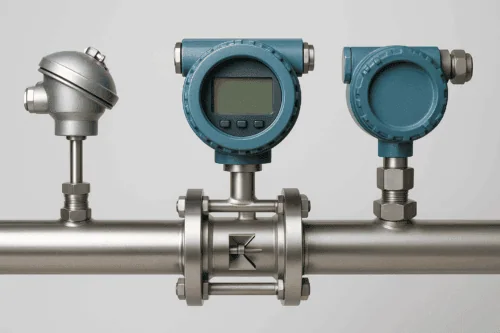Flow meters—whether turbine, Coriolis, electromagnetic, or ultrasonic, are designed to measure the movement of fluid through a pipe. But the raw flow reading doesn’t always represent the actual volume or mass of fluid being transferred, especially when temperature or pressure fluctuations are involved.
For instance, in gas applications, both temperature and pressure have a direct impact on gas density. A flow reading that doesn’t account for these variables could significantly misrepresent the actual mass or volumetric flow. Even in liquid applications, changes in pressure and temperature can influence fluid viscosity and density, which can affect the accuracy of the measurement.
Temperature and Pressure: Critical for Compensated Flow
Let’s break down how temperature and pressure probes contribute to a more complete and accurate flow measurement:
1. Temperature Compensation
Temperature changes can cause fluids to expand or contract. This affects both volume and density. In some processes—such as those involving cryogenic fluids, steam, or heated industrial liquids—this effect is dramatic.
For example, if you’re metering a fluid at 200°F but the flow meter is calibrated at room temperature, you’re introducing a significant source of error unless you compensate for the temperature difference. By integrating a temperature probe, your system can dynamically adjust the readings to provide a true mass or corrected volume flow, improving both safety and billing accuracy.
2. Pressure Compensation
Pressure also plays a crucial role in fluid behavior. In gas measurement in particular, pressure changes drastically impact the gas density and hence the mass flow. For liquids under high-pressure systems, changes can affect compressibility and flow dynamics. Without accounting for pressure, your flow readings can be skewed, particularly in high-pressure environments or systems with pressure fluctuations.
A pressure transducer allows your system to correct for real-time pressure variations, resulting in more reliable and traceable flow data.
Building a Complete System: How It Works
When temperature and pressure sensors are installed alongside your flow meter, the system can be configured to perform flow compensation—mathematically adjusting the raw flow readings to account for actual fluid conditions.
There are three primary configurations this might take:
- Volumetric flow with compensation: Base volumetric flow is adjusted using real-time temperature and/or pressure data to correct for changes in fluid density.
- Mass flow calculation: In systems without direct mass flow measurement (like with Coriolis meters), temperature and pressure data can be used to calculate mass flow from a volumetric reading.
- Condition monitoring: Even if you’re not adjusting the flow measurement directly, monitoring temperature and pressure can help diagnose process issues like cavitation, vapor locking, or unexpected system deviations.
Real-World Applications
Here are a few examples where integrated pressure and temperature probes are essential:
- Hydrogen fueling systems: Hydrogen is highly compressible and sensitive to both temperature and pressure. Accurate mass flow measurement is only possible with full compensation.
- Cryogenic liquid distribution: Extremely low temperatures require precise measurement to avoid system damage and product loss.
- Steam flow monitoring: Steam’s density changes significantly with pressure and temperature, making compensated mass flow measurement crucial for energy accounting.
- Pharmaceutical and food processing: Tight process control is required to meet safety and regulatory standards. Temperature and pressure data ensure product integrity and consistency.
- Benefits Beyond Accuracy
Incorporating temperature and pressure probes doesn’t just improve measurement accuracy—it enhances the reliability, safety, and efficiency of your entire system. Here’s how:
- Regulatory Compliance: Many industries require compensated flow data for custody transfer or quality control.
- Operational Insight: Real-time monitoring helps detect leaks, pressure drops, or thermal changes before they become issues.
- Process Optimization: Fine-tune flow rates, heat exchange, or pressurization based on actual process data—not just assumptions.
- Reduced Downtime: Early warnings from pressure or temperature anomalies can prevent costly shutdowns or equipment damage.
Integration Is Easier Than Ever
Modern flow measurement systems make integration seamless. Many turbine flow meters and digital transmitters can interface with external temperature and pressure sensors, consolidating data into a single, compensated output. Communication protocols like Modbus, HART, or analog signals allow easy integration with PLCs or control systems.
Better still, many instrumentation providers offer complete flow systems—preconfigured packages that include the flow meter, pressure sensor, temperature probe, and signal conditioning—ensuring accurate, reliable performance right out of the box.
